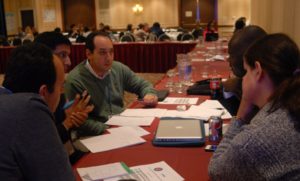
“The One Retinoblastoma World mission is to ensure that every caregiver has access to appropriate knowledge, skills, resources and collaborative opportunity to enable high quality evidence based care for each affected child, survivor and family.”
Every day, new strides are being made towards developing the field of eye cancer. Whether through published papers, international gatherings for ophthalmologists, or patient support group therapy, efficient communication remains a crucial contributor to progress. It was precisely the communication — in fact — between eye cancer patients and ocular oncologists that spearheaded The One Retinoblastoma World Conference that was held October 9-11, 2017 in Washington DC.

At this meeting, families, survivors, and doctors came together to inspire, share, educate, and learn concerning all matters of childhood retinoblastoma. But what, you may be wondering, is childhood retinoblastoma anyway? When born and throughout early stages of life, in areas like the United States where proper medical care is available, children are routinely screened for a childhood eye cancer called retinoblastoma. If diagnosed early, this disease is curable. However, as many as 7,000 children die each year due to improper diagnoses or in-access to proper medical care. No child should die, or suffer avoidable blindness because of that. One Retinoblastoma World is dedicated to breaking down the obstacles that prevent proper treatment for these children.
Ten questions asked by parents and survivors served as a basis for the meeting’s evolution. Because doctors and patients can sometimes be separated by the scope of complicated medical language, these questions better familiarized researchers with the common concerns of patients.
Here were some of the questions:
- Can we screen for retinoblastoma, and if not, what are the best ways to improve early diagnosis?
- What do my / my child’s genetics results mean for risk and screening, -current treatment, EUAs after treatment, and for adult life? What do we do if we can’t access genetic testing?
- How do doctors know when trying to save an eye is dangerous, and removing it is the only option? How do we best care for the socket throughout life?
- How do doctors and parents make the decision about adjuvant chemotherapy?
- What is the status of Rb in developing countries? I’ve been contacted by a family in a developing country whose child has Rb. What can I do to help them?
- What recommendations do you have for long term follow up care and screening in RB1 mutation carriers and children treated with chemotherapy / radiotherapy? How can you help us educate our primary doctors so they take us seriously, and what can we do if we have no access to a survivor / follow-up program?

Each of these questions were answered in a specific panel addressed by researchers, doctors, and clinicians to families and survivors. This proved greatly beneficial to those in attendance. But the collaborative effort did not stop there! The education these sessions provided were not restricted to those able to physically attend. Indeed, the meeting was live streamed to achieve global access for all. As the DC team explains:
“We wanted to make One Rb World 2017 truly a global event. We wanted parents, survivors and medical professionals to join us from across the USA and around the world, even if they couldn’t travel to Washington DC. Live stream viewers were able to interact with speakers and participate in discussions by sending written comments and questions via the live stream system. Their comments were received and shared by several dedicated volunteers in the conference room.”
The DC team is currently working with an editor to publish the livestream for future public viewing. Stay tuned to our blog posts to keep updated on when that will be! Additional information concerning One Rb World 2017 can be found here, including a full list of their program and the subjects of each panel.
One Retinoblastoma World 2017 marks a great advancement in the fight to defeat retinoblastoma. Through the efforts of specialists and advocates combined can we hope to ensure that all children have access to high quality care. We urge you to join us in the fight; have your voice be heard, and be a part of the cure.
To stay updated on all the latest in eye cancer research, please keep our website in your bookmarks!













